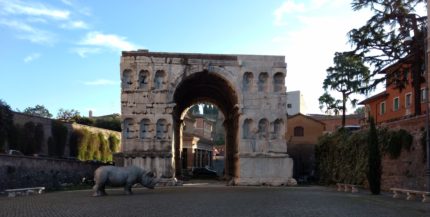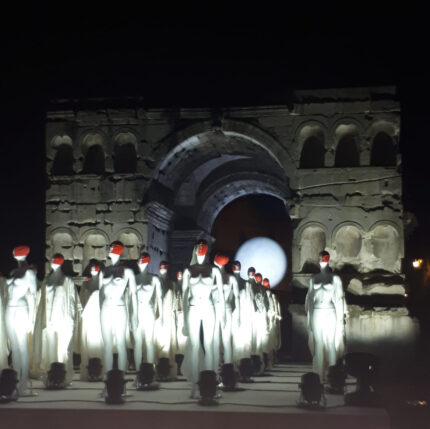Three years after my random encounter with a very life-like rhinocerous in front of the Arch of Janus, Rome’s only surviving quadrifons arch, I can now explain its presence. It was both promotional and symbolic. Dubbed the Rhinoceros at Saepta, the resin white rhinoceros was an art installation by Raffaele Curi announcing the opening of the restored Palazzo Rhinoceros, an early 20th century building housing the new art gallery of the Fondazione Alda Fendi – Esperimenti on the ground floor and a boutique hotel in the storeys above it. The rhino symbolized the ethos of The Fondazione, its Gallery and the refurbished Palazzo.
Space is always interconnected to the outdoor space, based on the principle that inspires the Philosophy of the Rhinoceros and the Fondazione Alda Fendi – Esperimenti: the perpetual juxtaposition between ancient and modern, between art indoors and outdoors, the spaces where it operates in a fruitful synergy of contaminations and interferences.
And thus the rhinoceros mystery is solved just in time to celebrate the reopening of the Arch of Janus to the public 28 years after it was fenced off when a car bomb exploded at the neighboring church of S. Giorgio in Velabro. The reopening of the arch was funded by the Fondazione Alda Fendi and the opening ceremony featured a performance staged by rhinoceros author Raffaele Curi. As of November 13th, the Arch can be visited by the public every Saturday from 10AM to 2PM and come next March, on Sundays from 4PM to 8PM, which will be extra cool because of the arch’s new lighting scheme. Admission is free.


…to the rescue :hattip:
Very much in contrast to that “Columbus” guy, the Portuguese indeed managed to find their way to the “real” Indians in India.
Thus, in 1515, ambassadors that had been sent to Sultan Muzaffar Shah II, ruler of Cambay (i.e. modern Gujarat), returned to Lisbon with diplomatic gifts, including a living rhinoceros:
The animal was examined by scholars and the curious, and letters describing the fantastic creature were sent to correspondents throughout Europe, and also to Nuremberg.
The earliest known image illustrates a poem by Florentine Giovanni Giacomo Penni, published in Rome on 13 July 1515. A more famous version was sketched by Dürer and later published by him as woodcut, cf.:
upload.wikimedia.org/wikipedia/commons/8/87/Durer_drawing.png
King Manuel, at last, decided to foreward the rhino as a gift to the Medici Pope Leo X in Rome.
The rhino embarked in December 1515. The vessel briefly stopped at an island off Marseilles for King Francis I of France to have a look.
After resuming its journey in January, unfortunately, the ship went down north of La Spezia, and the poor rhino, shackled to the deck to keep it under control and unable to swim, was drowned.
The dead rhino was returned to Lisbon, where its hide was stuffed. The dead animal’s fate in Rome remains unknown: it might have been removed to Florence by the Medici or destroyed in the 1527 sack of Rome.
There was not the popular sensation that the living beast had caused in Lisbon, although a rhino was depicted in contemporary paintings in Rome by Giovanni da Udine and Raphael.
Notably, the “kick-off” for the production of the classic “Fendi leather handbag” –just to point that out– of course took place much later :yes: